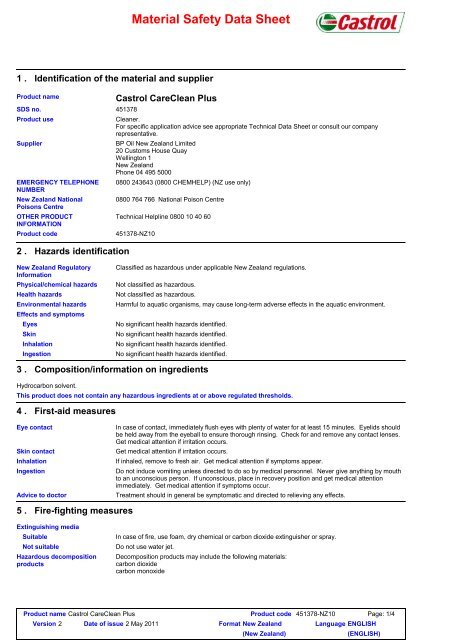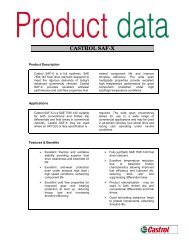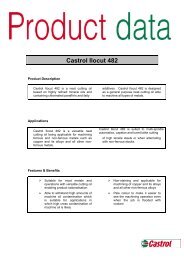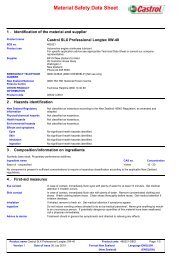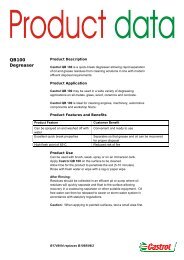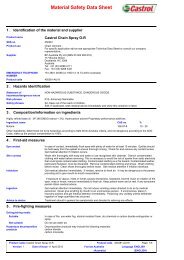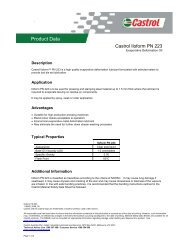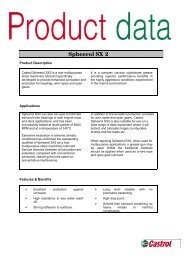Material Safety Data Sheet - Industrial Lubricants & Services Limited
Material Safety Data Sheet - Industrial Lubricants & Services Limited
Material Safety Data Sheet - Industrial Lubricants & Services Limited
Create successful ePaper yourself
Turn your PDF publications into a flip-book with our unique Google optimized e-Paper software.
<strong>Material</strong> <strong>Safety</strong> <strong>Data</strong> <strong>Sheet</strong><br />
1 . Identification of the material and supplier<br />
Product name<br />
SDS no.<br />
Product use<br />
Supplier<br />
EMERGENCY TELEPHONE<br />
NUMBER<br />
New Zealand National<br />
Poisons Centre<br />
OTHER PRODUCT<br />
INFORMATION<br />
Product code<br />
Castrol CareClean Plus<br />
451378<br />
Cleaner.<br />
For specific application advice see appropriate Technical <strong>Data</strong> <strong>Sheet</strong> or consult our company<br />
representative.<br />
BP Oil New Zealand <strong>Limited</strong><br />
20 Customs House Quay<br />
Wellington 1<br />
New Zealand<br />
Phone 04 495 5000<br />
0800 243643 (0800 CHEMHELP) (NZ use only)<br />
0800 764 766 National Poison Centre<br />
Technical Helpline 0800 10 40 60<br />
451378-NZ10<br />
2 .<br />
Hazards identification<br />
New Zealand Regulatory<br />
Information<br />
Physical/chemical hazards<br />
Health hazards<br />
Environmental hazards<br />
Effects and symptoms<br />
Eyes<br />
Skin<br />
Inhalation<br />
Ingestion<br />
Classified as hazardous under applicable New Zealand regulations.<br />
Not classified as hazardous.<br />
Not classified as hazardous.<br />
Harmful to aquatic organisms, may cause long-term adverse effects in the aquatic environment.<br />
No significant health hazards identified.<br />
No significant health hazards identified.<br />
No significant health hazards identified.<br />
No significant health hazards identified.<br />
3 .<br />
Composition/information on ingredients<br />
Hydrocarbon solvent.<br />
This product does not contain any hazardous ingredients at or above regulated thresholds.<br />
4 .<br />
First-aid measures<br />
Eye contact<br />
Skin contact<br />
Inhalation<br />
Ingestion<br />
Advice to doctor<br />
In case of contact, immediately flush eyes with plenty of water for at least 15 minutes. Eyelids should<br />
be held away from the eyeball to ensure thorough rinsing. Check for and remove any contact lenses.<br />
Get medical attention if irritation occurs.<br />
Get medical attention if irritation occurs.<br />
If inhaled, remove to fresh air. Get medical attention if symptoms appear.<br />
Do not induce vomiting unless directed to do so by medical personnel. Never give anything by mouth<br />
to an unconscious person. If unconscious, place in recovery position and get medical attention<br />
immediately. Get medical attention if symptoms occur.<br />
Treatment should in general be symptomatic and directed to relieving any effects.<br />
5 .<br />
Fire-fighting measures<br />
Extinguishing media<br />
Suitable<br />
Not suitable<br />
Hazardous decomposition<br />
products<br />
In case of fire, use foam, dry chemical or carbon dioxide extinguisher or spray.<br />
Do not use water jet.<br />
Decomposition products may include the following materials:<br />
carbon dioxide<br />
carbon monoxide<br />
Product name Castrol CareClean Plus<br />
Product code 451378-NZ10<br />
Page: 1/4<br />
Version 2 Date of issue 2 May 2011<br />
Format New Zealand<br />
Language ENGLISH<br />
(New Zealand)<br />
(ENGLISH)
Unusual fire/explosion<br />
hazards<br />
In a fire or if heated, a pressure increase will occur and the container may burst.<br />
Special fire-fighting<br />
procedures<br />
Protection of fire-fighters<br />
No action shall be taken involving any personal risk or without suitable training. Promptly isolate the<br />
scene by removing all persons from the vicinity of the incident if there is a fire. This material is harmful<br />
to aquatic organisms. Fire water contaminated with this material must be contained and prevented<br />
from being discharged to any waterway, sewer or drain.<br />
Fire-fighters should wear appropriate protective equipment and self-contained breathing apparatus<br />
(SCBA) with a full face-piece operated in positive pressure mode. Clothing for fire-fighters (including<br />
helmets, protective boots and gloves) conforming to European standard EN 469 will provide a basic<br />
level of protection for chemical incidents.<br />
6 . Accidental release measures<br />
Personal precautions<br />
Environmental precautions<br />
Large spill<br />
Small spill<br />
No action shall be taken involving any personal risk or without suitable training. Evacuate surrounding<br />
areas. Keep unnecessary and unprotected personnel from entering. Do not touch or walk through<br />
spilt material. Avoid breathing vapour or mist. Provide adequate ventilation. Wear appropriate<br />
respirator when ventilation is inadequate. Put on appropriate personal protective equipment (see<br />
Section 8).<br />
Avoid dispersal of spilt material and runoff and contact with soil, waterways, drains and sewers. Inform<br />
the relevant authorities if the product has caused environmental pollution (sewers, waterways, soil or<br />
air). Water polluting material.<br />
Stop leak if without risk. Move containers from spill area. Approach the release from upwind. Prevent<br />
entry into sewers, water courses, basements or confined areas. Wash spillages into an effluent<br />
treatment plant or proceed as follows. Contain and collect spillage with non-combustible, absorbent<br />
material e.g. sand, earth, vermiculite or diatomaceous earth and place in container for disposal<br />
according to local regulations. Dispose of via a licensed waste disposal contractor. Contaminated<br />
absorbent material may pose the same hazard as the spilt product.<br />
Stop leak if without risk. Move containers from spill area. Dilute with water and mop up if watersoluble.<br />
Alternatively, or if water-insoluble, absorb with an inert dry material and place in an<br />
appropriate waste disposal container. Dispose of via a licensed waste disposal contractor.<br />
7 .<br />
Handling and storage<br />
Handling<br />
Storage<br />
Avoid contact of spilt material and runoff with soil and surface waterways.<br />
Store and use only in equipment/containers designed for use with this product. Keep away from heat<br />
and direct sunlight. Keep container tightly closed and sealed until ready for use. Containers that have<br />
been opened must be carefully resealed and kept upright to prevent leakage. Do not store in<br />
unlabelled containers. Store in accordance with local regulations. Store in a dry, cool and wellventilated<br />
area, away from incompatible materials (see Section 10).<br />
8 . Exposure controls/personal protection<br />
Occupational exposure limits<br />
Exposure controls<br />
Occupational exposure<br />
controls<br />
Hygiene measures<br />
Personal protective equipment<br />
Respiratory protection<br />
Skin and body<br />
Hand protection<br />
Eye protection<br />
No exposure standard allocated.<br />
Provide exhaust ventilation or other engineering controls to keep the airborne concentrations of<br />
vapours below their respective occupational exposure limits.<br />
All activities involving chemicals should be assessed for their risks to health, to ensure exposures are<br />
adequately controlled. Personal protective equipment should only be considered after other forms of<br />
control measures (e.g. engineering controls) have been suitably evaluated. Personal protective<br />
equipment should conform to appropriate standards, be suitable for use, be kept in good condition and<br />
properly maintained.<br />
Your supplier of personal protective equipment should be consulted for advice on selection and<br />
appropriate standards. For further information contact your national organisation for standards.<br />
The final choice of protective equipment will depend upon a risk assessment. It is important to ensure<br />
that all items of personal protective equipment are compatible.<br />
Wash hands, forearms and face thoroughly after handling chemical products, before eating, smoking<br />
and using the lavatory and at the end of the working period. Ensure that eyewash stations and safety<br />
showers are close to the workstation location.<br />
Avoid breathing of vapours, mists or spray. Select and use respirators in accordance with AS/NZS<br />
1715/1716. When mists or vapours exceed the exposure standards then the use of the following is<br />
recommended: Approved respirator with organic vapour and dust/mist (Type P1) filters. Filter<br />
capacity and respirator type depends on exposure level.<br />
None required.<br />
None required.<br />
<strong>Safety</strong> glasses with side shields.<br />
Product name Castrol CareClean Plus<br />
Product code 451378-NZ10<br />
Page: 2/4<br />
Version 2 Date of issue 2 May 2011<br />
Format New Zealand<br />
Language ENGLISH<br />
(New Zealand)<br />
(ENGLISH)
9 .<br />
Physical and chemical properties<br />
Physical state<br />
Liquid.<br />
Colour<br />
Yellow.<br />
pH 6 to 7<br />
Density<br />
1000 kg/m 3 (1 g/cm 3 ) at 15°C<br />
Solubility<br />
Soluble in water.<br />
10 . Stability and reactivity<br />
Stability<br />
Conditions to avoid<br />
Incompatibility with various<br />
substances/Hazardous<br />
Reactions<br />
Hazardous decomposition<br />
products<br />
The product is stable.<br />
Avoid extreme temperatures, strong oxidizers, fire.<br />
No hazardous reactions identified.<br />
Decomposition products may include the following materials:<br />
carbon dioxide<br />
carbon monoxide<br />
11 . Toxicological information<br />
Chronic toxicity<br />
Carcinogenic effects<br />
Mutagenic effects<br />
12 . Ecological information<br />
No component of this product at levels greater than or equal to 0.1% is identified as a carcinogen by<br />
ACGIH, the International Agency for Research on Cancer (IARC), the European Commission (EC), or<br />
the National Occupational Health and <strong>Safety</strong> Commission (Australia).<br />
No known significant effects or critical hazards.<br />
Biodegradability<br />
Persistence/degradability<br />
Environmental hazards<br />
The biodegradability of this material has not been determined.<br />
No ecotoxicity or ecological information to report.<br />
13 . Disposal considerations<br />
Disposal considerations /<br />
Waste information<br />
The generation of waste should be avoided or minimised wherever possible. Empty containers or<br />
liners may retain some product residues. This material and its container must be disposed of in a safe<br />
way. Significant quantities of waste product residues should not be disposed of via the foul sewer but<br />
processed in a suitable effluent treatment plant. Dispose of surplus and non-recyclable products via a<br />
licensed waste disposal contractor. Disposal of this product, solutions and any by-products should at<br />
all times comply with the requirements of environmental protection and waste disposal legislation and<br />
any regional local authority requirements. Avoid dispersal of spilt material and runoff and contact with<br />
soil, waterways, drains and sewers.<br />
If disposal is to be via incineration, this must use an approved process, e.g., combustion in a cement<br />
kiln.<br />
14 . Transport information<br />
International transport regulations<br />
Not classified as hazardous for transport (NZ Standard 5433, UN, IATA/ICAO, IMO).<br />
15 . Regulatory information<br />
New Zealand Hazard Classification<br />
HSNO Classification<br />
HSNO Approval Number<br />
HSR002552<br />
Name of the Group Standard Cosmetic Products Group Standard 2006<br />
Information on Conditions of<br />
the Group Standard<br />
Risk and <strong>Safety</strong> Phrases<br />
Risk phrases<br />
<strong>Safety</strong> phrases<br />
Other regulations<br />
United States inventory<br />
(TSCA 8b)<br />
Ecotoxic in the Aquatic Environment - Ecotoxicity Class - 9.1D<br />
R52/53- Harmful to aquatic organisms, may cause long-term adverse effects in the aquatic<br />
environment.<br />
S23- Do not breathe vapour or spray.<br />
S51- Use only in well-ventilated areas.<br />
S61- Avoid release to the environment. Refer to special instructions/safety data sheet.<br />
REACH Status For the REACH status of this product please consult your company contact, as identified in Section 1.<br />
At least one component is not listed.<br />
Product name Castrol CareClean Plus<br />
Product code 451378-NZ10<br />
Page: 3/4<br />
Version 2 Date of issue 2 May 2011<br />
Format New Zealand<br />
Language ENGLISH<br />
(New Zealand)<br />
(ENGLISH)
Australia inventory (AICS)<br />
Canada inventory<br />
China inventory (IECSC)<br />
Japan inventory (ENCS)<br />
Korea inventory (KECI)<br />
Philippines inventory<br />
(PICCS)<br />
All components are listed or exempted.<br />
At least one component is not listed.<br />
At least one component is not listed.<br />
All components are listed or exempted.<br />
At least one component is not listed.<br />
Not determined.<br />
16 . Other information<br />
Key to abbreviations<br />
AMP = Acceptable Maximum Peak<br />
ACGIH = American Conference of Governmental <strong>Industrial</strong> Hygienists, an agency that promulgates<br />
exposure standards.<br />
ADG = Australian Code for the Transport of Dangerous Goods by Road and Rail<br />
ADG Code = Australian Code for the Transport of Dangerous Goods by Road and Rail<br />
CAS Number = Chemical Abstracts Service Registry Number<br />
HAZCHEM Code = Emergency action code of numbers and letters which gives information to<br />
emergency services. Its use is required by the ADG Code for Dangerous Goods in bulk.<br />
ICAO = International Civil Aviation Organization.<br />
IATA = International Air Transport Association, the organization promulgating rules governing<br />
shipment of goods by air.<br />
IMDG = International Maritime Organization Rules, rules governing shipment of goods by water.<br />
IP 346 = A chemical screening assay for dermal toxicity. The European Commission has<br />
recommended that Method IP 346 be used as the basis for labelling certain lubricant oil base stocks<br />
for carcinogenicity. The EU Commission has stipulated that the classification as a carcinogen need<br />
not apply if it can be shown that the substance contains less than 3% DMSO extract as measured by<br />
IP 346. (See Note L, European Commission Directive 67/548/EEC as amended and adapted.) DMSO<br />
is a solvent.<br />
NOHSC = National Occupational Health & <strong>Safety</strong> Commission, Australia<br />
TWA = Time weighted average<br />
STEL = Short term exposure limit<br />
UN Number = United Nations Number, a four digit number assigned by the United Nations Committee<br />
of Experts on the Transport of Dangerous Goods.<br />
History<br />
Date of issue<br />
Date of previous issue<br />
Prepared by<br />
Notice to reader<br />
02/05/2011.<br />
14/03/2011.<br />
Product Stewardship<br />
All reasonably practicable steps have been taken to ensure this data sheet and the health, safety and environmental information<br />
contained in it is accurate as of the date specified below. No warranty or representation, express or implied is made as to the accuracy or<br />
completeness of the data and information in this data sheet.<br />
The data and advice given apply when the product is sold for the stated application or applications. You should not use the product other<br />
than for the stated application or applications without seeking advice from us.<br />
It is the user’s obligation to evaluate and use this product safely and to comply with all applicable laws and regulations. The BP Group<br />
shall not be responsible for any damage or injury resulting from use, other than the stated product use of the material, from any failure to<br />
adhere to recommendations, or from any hazards inherent in the nature of the material. Purchasers of the product for supply to a third<br />
party for use at work, have a duty to take all necessary steps to ensure that any person handling or using the product is provided with the<br />
information in this sheet. Employers have a duty to tell employees and others who may be affected of any hazards described in this sheet<br />
and of any precautions that should be taken.<br />
Product name Castrol CareClean Plus<br />
Product code 451378-NZ10<br />
Page: 4/4<br />
Version 2 Date of issue 2 May 2011<br />
Format New Zealand<br />
Language ENGLISH<br />
(New Zealand)<br />
(ENGLISH)


